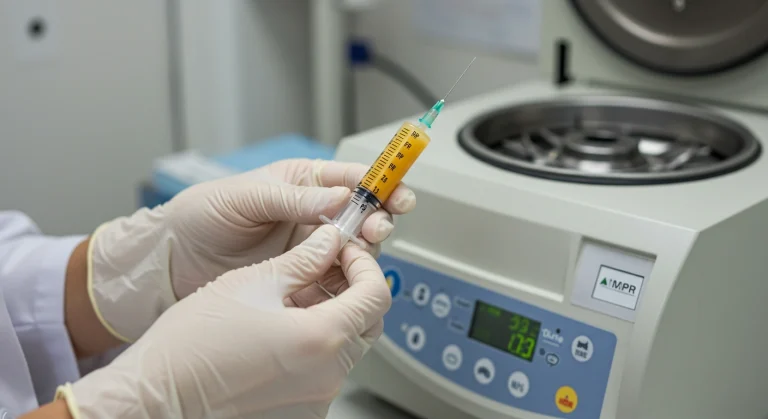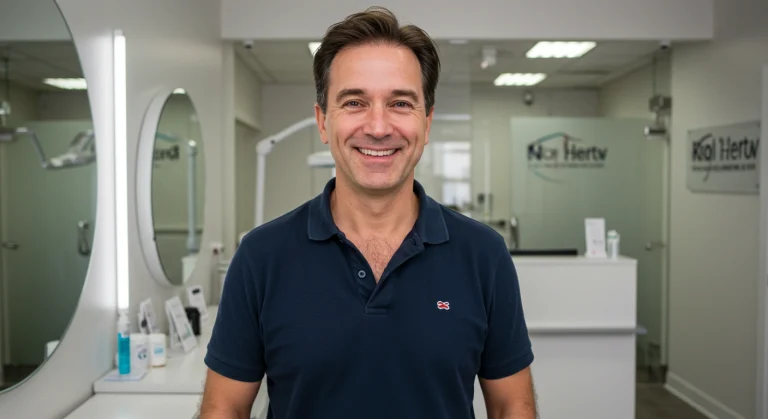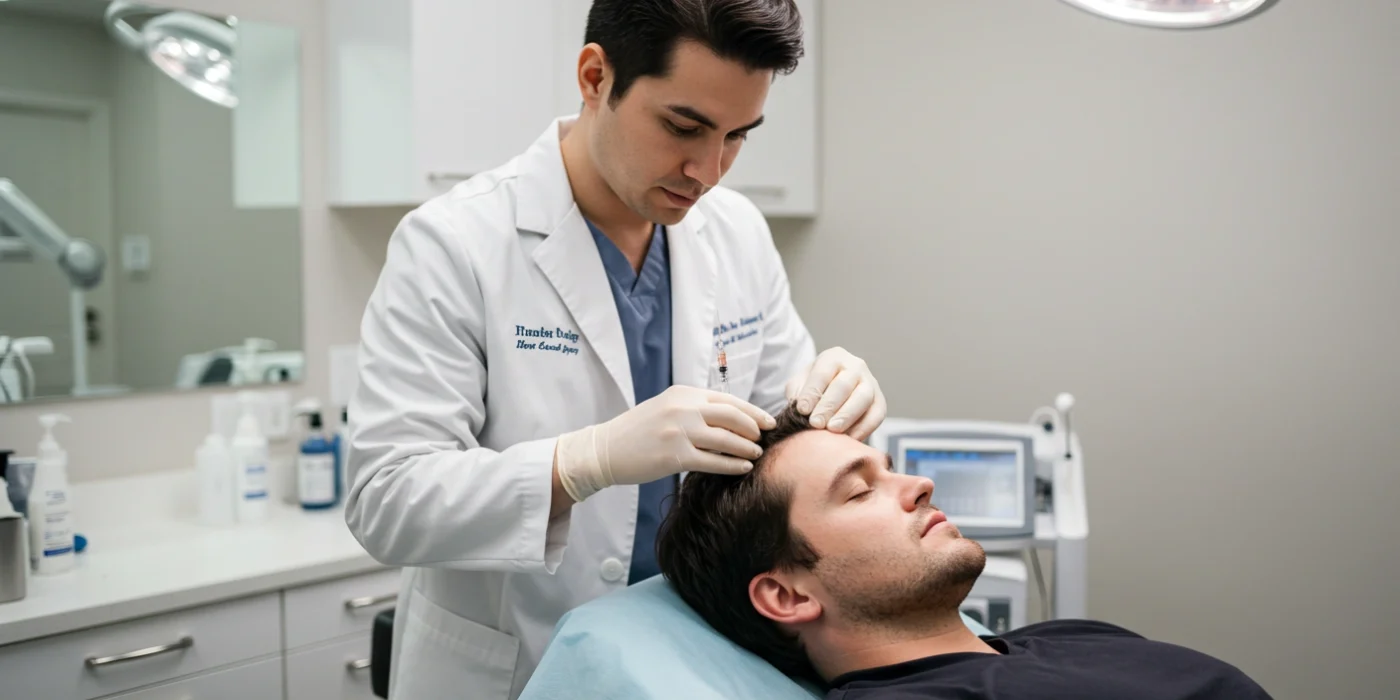PRP therapy is an advanced treatment designed to promote hair growth by using the regenerative properties of your own blood. The process involves extracting blood from the patient, processing it to concentrate the platelets, and then injecting the plasma into the scalp. PRP therapy has shown promising results for people experiencing thinning hair, hair loss, and other scalp issues.
Before undergoing it for hair growth, it’s essential to understand how the treatment works, what results you can expect, and whether you’re a suitable candidate. Let’s explore these topics in detail so you can make an informed decision.
"Everything has beauty, but not everyone sees it."
Confucius
What is PRP Therapy?
Definition of PRP Therapy
PRP therapy for hair growth involves using Platelet-Rich Plasma, a concentrated source of platelets derived from your own blood. The platelets contain growth factors that can stimulate hair follicles, promote hair regeneration, and increase hair thickness.
The process starts by drawing a small amount of your blood, which is then processed in a centrifuge to separate the platelet-rich plasma from the red blood cells and other components. The final product, PRP, is then injected into the scalp, where it works to rejuvenate hair follicles and stimulate new hair growth.
Difference Between PRP and Other Regenerative Treatments
The therapy differs from other regenerative treatments such as stem cell therapy or microneedling, which also aim to encourage hair growth. While stem cell therapy involves the use of stem cells to regenerate tissue, PRP uses the body’s own natural platelets to promote healing and stimulate hair growth.
Unlike microneedling, which creates small punctures in the skin to stimulate collagen production, PRP directly injects concentrated growth factors into the scalp to accelerate healing and hair regeneration.
PRP therapy is often viewed as a more natural approach to hair restoration, as it utilizes your own blood, thereby minimizing the risk of allergic reactions or rejection.
Who Is a Good Candidate for PRP Hair Therapy?
Types of Hair Loss It Can Address
PRP hair therapy is effective for individuals with androgenetic alopecia (commonly referred to as male and female pattern baldness), telogen effluvium (temporary hair shedding), and other forms of hair thinning.
It is beneficial for people in the early to moderate stages of hair loss. If you’re experiencing thinning at the crown, receding hairline, or patchy bald spots, it could help regenerate hair growth in those areas.
When PRP Might Not Be Effective
While it can offer significant benefits for many, it may not be as effective for individuals with advanced hair loss or complete baldness. If the hair follicles in the affected areas are too damaged or inactive, PRP may not be able to stimulate new growth.
Additionally, the therapy may not work as well for those with underlying medical conditions that impact hair growth, such as autoimmune disorders, severe hormonal imbalances, or scarring alopecia.
If you’re unsure whether it is right for you, a consultation with a professional can help assess your condition and determine the best course of action.

What to Expect During the PRP Therapy Process
Step-by-Step Breakdown of the Procedure
The PRP therapy for hair restoration typically follows these steps:
- Blood Draw: A small amount of your blood is drawn, typically from your arm.
- Blood Processing: The blood is placed in a centrifuge to separate the platelet-rich plasma from other components of the blood.
- Scalp Preparation: Your scalp is cleaned and numbed with a local anesthetic to reduce any discomfort during the injections.
- Injection: The processed PRP is injected into specific areas of your scalp where hair thinning or hair loss is occurring.
- Post-Procedure Care: You will be given instructions for aftercare, which may include avoiding washing your hair for one to two days and refraining from vigorous physical activity for a short period.
Is PRP Therapy Painful?
While PRP injections are generally well-tolerated, you may experience mild discomfort during the procedure. The local anesthetic used to numb your scalp minimizes any pain associated with the injections. After the procedure, some people may feel slight tenderness, swelling, or redness in the treated areas, but these symptoms usually subside within a few days.
Session Frequency and Duration
Typically, PRP therapy requires multiple sessions to achieve the desired results. Most patients undergo 3 to 4 treatments spaced about 4 to 6 weeks apart. After the initial series of treatments, maintenance sessions every 4 to 6 months may be recommended to maintain results and continue stimulating hair growth.
Each session usually lasts between 30 and 60 minutes, depending on the size of the treatment area.
Potential Side Effects and Safety Concerns
Common Side Effects
As the therapy uses your own blood, the risk of allergic reactions is minimal. However, some common side effects can include:
- Mild pain or discomfort at the injection sites
- Redness or swelling on the scalp
- Bruising in the treated area
- Scalp tenderness
These side effects are typically temporary and resolve within a few days after the procedure.
Rare but Serious Risks
Although rare, there are some potential risks associated with it. These can include infection or injury to blood vessels at the injection sites. However, these risks are significantly reduced when a qualified and experienced professional performs the procedure in a sterile environment.
Is PRP Hair Therapy Safe?

PRP therapy is generally considered safe, especially when administered by a licensed practitioner. Since the procedure uses your blood, the risk of complications or adverse reactions is much lower than with other treatments. As with any medical procedure, it’s important to discuss any concerns with your provider before proceeding.
How Long Until You See Results from PRP Therapy?
Timeline of Hair Growth Progress
It typically produces noticeable results within 3 to 6 months, although full results may take up to a year to be fully realized. Hair growth begins with the rejuvenation of existing hair follicles, which leads to thicker, healthier hair over time. The process is gradual, so you may not see significant changes immediately.
Factors That Affect Results
Several factors can influence how well PRP therapy works for you, including:
- The severity of hair loss: The earlier you begin treatment, the better the chances of success.
- Hair type and thickness: Some hair types respond better to it than others.
- Overall health: Your general health and lifestyle habits, including diet and stress levels, can also affect the effectiveness of PRP treatments.
- Consistency of treatment: Following the recommended treatment schedule and attending follow-up sessions is essential for achieving optimal results.
Cost of PRP Therapy for Hair Growth
Average Price Range per Session
The cost of PRP hair therapy can vary based on location, clinic reputation, and the number of sessions required. On average, each session costs between $500 and $1,500. If multiple sessions are needed, the total cost can range from $2,000 to $5,000 or more.
Insurance and Financing Options
Unfortunately, most insurance plans do not cover hair therapy, as it is considered a cosmetic procedure. However, many clinics offer financing options to help make treatment more affordable. It’s essential to ask about financing plans or payment options when you’re inquiring about the cost of treatment.
Choosing the Right Clinic for PRP Therapy
What to Look for in a Provider
When selecting a clinic for PRP therapy, consider the following:
- Qualified professionals: Ensure the clinic employs licensed and experienced medical professionals, such as dermatologists or hair restoration specialists, who are trained in the therapy.
- Clinic reputation: Research online reviews, ask for referrals, and check the clinic’s portfolio of before-and-after photos from previous patients.
- Cleanliness and safety: Ensure the clinic maintains high standards of hygiene and adheres to proper safety protocols to minimize the risk of infection or complications.
Questions to Ask Before Booking
Before booking your appointment, here are a few questions to ask the clinic:
- What is the clinic’s success rate with PRP therapy for hair growth?
- How many sessions will I need, and what will be the total cost?
- Will I need any follow-up treatments after the initial sessions?
- Are there any lifestyle or health considerations I should take into account before the procedure?
Conclusion
PRP therapy for hair growth is a promising treatment option for individuals dealing with thinning hair or hair loss. By understanding the procedure, its benefits, and how to prepare for optimal results, you can make an informed decision about whether the therapy is right for you. If you’re considering it, consult with a qualified provider to discuss your goals and expectations, and enjoy the benefits of healthier, thicker hair.

